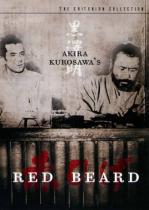Akahige
 Year:
Year: 1965
Film Studio: Toho
Genre: Drama
Length: 185 Min.
DirectorAkira Kurosawa (1910)
WritingMasato Ide (1922)...Screenwriter
Hideo Oguni (1904)...Screenwriter
Ryûzô Kikushima...Screenwriter
Akira Kurosawa (1910)...Screenwriter
ProducerRyûzô Kikushima
Tomoyuki Tanaka (1910)
CinematographerAsakazu Nakai (1901)
Takao Saitô (1920)
MusicMasaru Satô (1928)...Composer
StarsToshirô Mifune (1920) as Dr. Kyojô Niide
Yûzô Kayama (1937) as Dr. Noboru Yasumoto
Tsutomu Yamazaki (1936) as Sahachi
Reiko Dan (1935) as Osugi
Miyuki Kuwano (1942) as Onaka
Kyôko Kagawa (1931) as Madwoman
Tatsuyoshi Ehara (1937) as Genzô Tsugawa
Terumi Niki (1949) as Otoyo
Review For nearly twenty years Akira Kurosawa and Toshirô Mifune had forged a film partnership that could only be rivaled by famed director John Ford and his stalwart performer John Wayne. When Mifune had auditioned at an open search for new talent at Toho studios in 1946, Kurosawa saw in the young man the essential skills needed to become a great actor, and the rest was history. Their talents would be showcased on the world film stage in 1950 when their fifth film collaboration,
Rashômon won the prestigious Golden Lion at the Venice Film Festival. What followed would be a successful string of classic cinematic works that have never been rivaled by any director or actor since.
Shichinin no samurai,
Kumonosu jô,
Yojimbo,
Tsubaki Sanjûrô and
High and Low are all considered the highest form of creative art, qualified by Kurosawa’s attention to detail and Mifune’s screen presence. But it would be Kurosawa’s determination for screen realism in their next film that would sever this most prodigious and prestigious relationship.
After the success of
High and Low, work began on what would be their last collaboration,
Akahige (Red Beard). At that time, no one associated with the production could have realized that Kurosawa’s focus on authenticity would prolong filmmaking for close to two years. All the while, barring Mifune from accepting any other work due to the fact that the beard he had grown for the role could not be shaved off. When filming had begun, Mifune had just created his own production company and he was eager to make his own films and prove that he wasn’t just a cog in the Kurosawa film machine. In the end, the frustrations of both men would build a wall between the two and after the films release, they went their separate ways. In the following years, both their careers would be sidetracked for different reasons. Kurosawa would also form his own production company, but his first film release
Dô desu ka den was a box office failure and dissolved the company, leading to an un-successful suicide attempt by the director. Mifune, on the other hand, starred in a string of very successful films over the next decade, all of which were profitable, but were inferior in quality to anything he had made with Kurosawa. In essence, Mifune had exchanged artistic integrity for the benefit of a steady paycheck, and his career would never be lauded over again.
Akahige tells the story of a young intern named Yasumoto (Yuzo Kayama), fresh from a stint in a Nagasaki hospital run by Dutch physicians, who is sent to a clinic run by a Dr. Niide (Mifune). Niide operates the Koshikawa clinic, a small facility that tends to the needs of the impoverished. At first, Yasumoto is outraged that he will have to spend his internship caring for peasants and vagabonds instead of being the primary physician of the Shogunate. In the beginning, he rebels against his new instructor and his strict methods for insuring his patient’s recovery. Yasumoto only sees Niide as someone who wants to steal the medical knowledge he has attained from the advanced Dutch physicians he has just study under. But, when Niide saves the young doctors life from an attack by a beautiful, seductive and clearly deranged patient, he starts to see that his new mentor is a doctor of un-paralleled sincerity. Slowly, he assimilates into the day to day life at the clinic and he starts to see his patients as troubled human souls that are in desperate need of care and whose lives he can improve.
If you are accustomed to the jidai-geki samurai films that Kurosawa has become famous for, then this film may not appeal to you. It is a complete departure from that genre of filmmaking. From beginning to end, its focus is on the human drama of the impoverished and how society deals with them. But, if you can allow yourself to become absorbed in the story, you will be rewarded with over three hours of impeccable film creativity and storytelling. As I have stated before, Akira Kurosawa was un-rivaled in cinematic history as a master of cinematography and of character framing. Every sequence in the film is exquisitely composed as if Kurosawa was crafting an artistic masterpiece on canvas. Once again, in the hands of the master, the story never drags as it slowly entices you with its emotions and attention to detail. If you give it a chance, you will be rewarded ten fold for the effort.
Ratings Criterion
- The pinnacle of film perfection and excellence.

- Not quite an immortal film, yet a masterpiece in its own right.

- Historically important film, considered a classic.

- An entertaining film that’s fun or engaging to watch.

– A good film that’s worth a Netflix venture.

- Borderline viewable.

– A bad film that may have a moment of interest.

– Insipid, trite and sophomoric, and that's its good points.

– A film so vacuous, it will suck 2 hours from the remainder of your life.

- A gangrenous and festering pustule in the chronicles of celluloid.